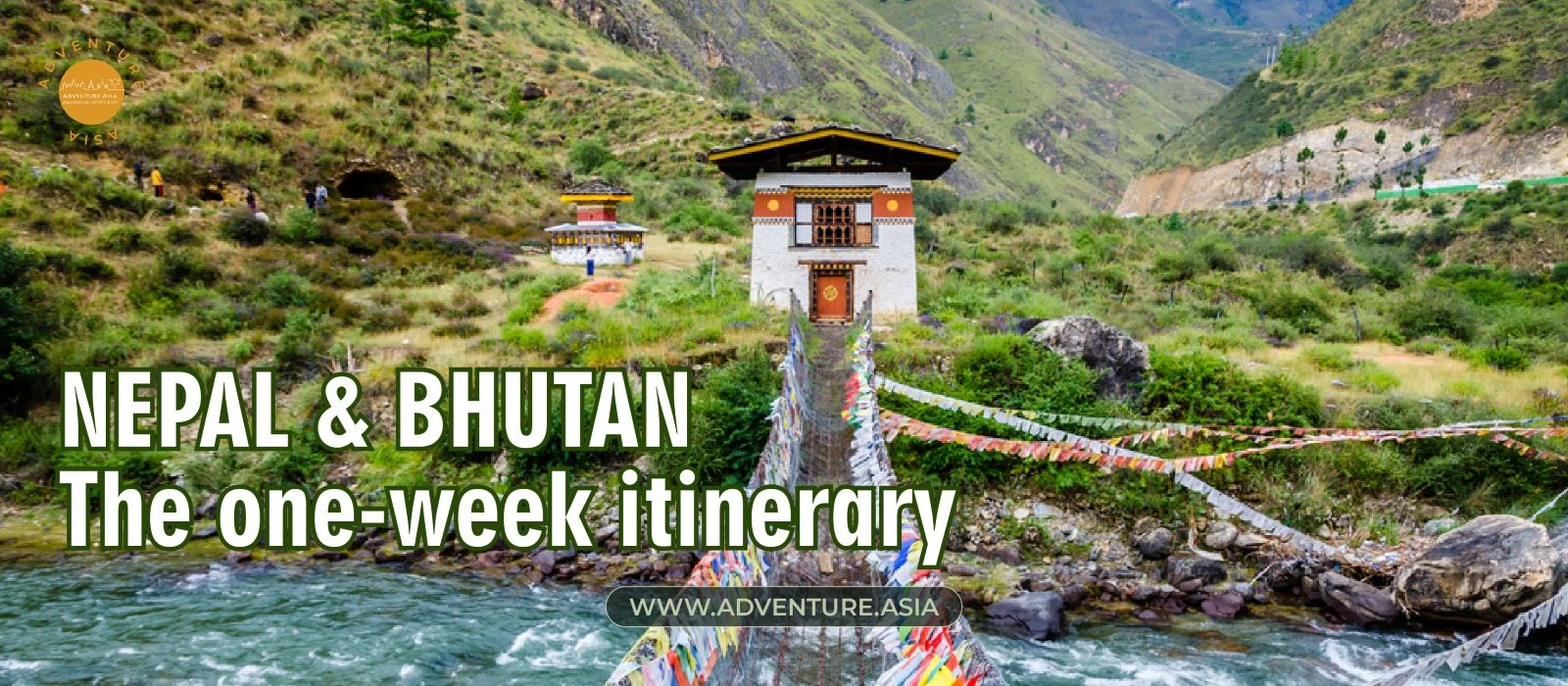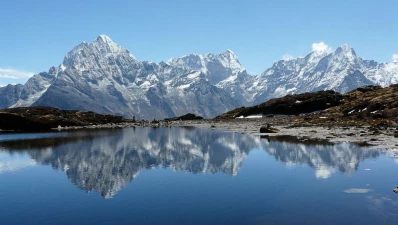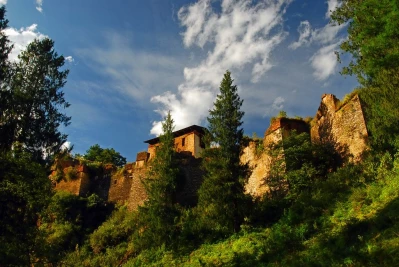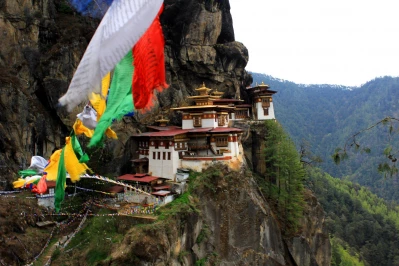
Exploring Nepal and Bhutan: A One-Week Itinerary with Full Guide
- 1. Exploring Nepal and Bhutan
- 2. Best time to visit Nepal and Bhutan
- 3. Exploring Nepal and Bhutan: Adventures and Cultural Delights
- 4. What to pack for a trip to Nepal and Bhutan
- 5. A one-week itinerary in Nepal and Bhutan
Nepal and Bhutan, nestled in the heart of South Asia, are treasures waiting to be discovered. Nepal, boasting the towering heights of the planet’s highest peak, offers a tapestry of vibrant culture and serene natural landscapes. Its neighbor, Bhutan, shrouded in seclusion, captivates with its preservation of age-old traditions amidst the currents of globalization.
While the allure of Bhutan beckons many, travelers often find themselves relying on tour operators due to government regulations. In response, EU Asia presents an adapted itinerary, a meticulously crafted 8-day, 7-night journey that encompasses both countries. Whether you're charting your own course or seeking expert guidance, this itinerary serves as a roadmap to the wonders of these captivating destinations.
1. Exploring Nepal and Bhutan
Nepal and Bhutan hold a coveted place on the bucket lists of travelers seeking new horizons. Once deemed the 'forbidden kingdoms', these nations, shielded by the towering Himalayas, were inaccessible to outsiders. Yet, with the advent of tourism, these countries have emerged as sought-after destinations, drawing adventurers and holiday makers alike.
Despite being landlocked and petite in size, The mountains in Nepal and Bhutan and their breathtaking natural scenery will give you a wonderful experience. Trekkers, mountaineers, bikers, photographers, and filmmakers are drawn to these lands, where exotic cultures and spiritualism abound.
Linked by air and land routes, these countries are easily traversed. Nepal-Bhutan travel packages, offering seamless multi-country experiences, stand as a testament to the enduring appeal of these captivating nations in South Asia.
2. Best time to visit Nepal and Bhutan
While cultural tours are feasible year-round, the prime seasons for visiting Nepal and Bhutan are spring (March-May), autumn (September-November), and early winter (December). Nestled beneath the majestic Himalayan range, both countries share similar climate and weather patterns, making the timing of visits relatively consistent.
- Spring (March-May): Pleasant temperatures 59-77°F (15-25°C) with occasional rain showers. Ideal for sightseeing and lower altitude treks with blooming rhododendrons adding a colorful touch.
- Autumn (September-November): The favored season for trekking with clear skies, moderate temperatures 55-68°F (13-20°C), and breathtaking views of the Himalayas. Perfect for outdoor enthusiasts.
- Early Winter (December): Clear skies with cold days around 50°F (10°C) and freezing nights. High-altitude areas experience snowfall. While trekking at high altitudes might be challenging, lower altitude areas and cultural exploration are still enjoyable.
Travelers can align their Nepal and Bhutan tours with the festive seasons to immerse themselves in the vibrant cultural tapestry of these nations. Nepal hosts a plethora of colorful festivals such as Holi, Bisket Jatra, and Mahashivaratri, with the grand celebrations of Dashain and Tihar taking center stage during autumn.
Meanwhile, Bhutan boasts festivals nearly every month, predominantly held in monasteries. These festivals provide a glimpse into the profound influence of Buddhism on Bhutanese society. Masked dances and theatrical performances by monks enthrall participants, symbolizing the reception of blessings and positive energy from Buddhist deities.
Among Bhutan's diverse festivals, Tshechu stands out as a vibrant religious celebration held in major cities and towns. Additionally, events like the Nomad Festival, Black-Necked Crane Festival, Matsutake Festival, Haa Summer Festival, and Jomolhari Mountain Festival offer unique insights into Bhutan's rich cultural heritage.
3. Exploring Nepal and Bhutan: Adventures and Cultural Delights
Nepal offers a plethora of adventure activities, including iconic treks like the Everest Base Camp Trek and Annapurna Circuit. Renowned for its mountainous terrain, Nepal boasts eight of the world's fourteen highest peaks, making it a paradise for climbers. Additionally, the country offers diverse adventure options such as rafting, paragliding, wildlife safaris, and more. Visitors can also explore Nepal's rich cultural heritage through UNESCO World Heritage Sites like Boudhanath and Pashupatinath, as well as numerous Hindu and Buddhist pilgrimage sites.
Meanwhile, Bhutan's lush landscapes provide an ideal setting for nature and wildlife enthusiasts. Trekking trails like the Druk Path Trek and biking routes through picturesque valleys offer immersive experiences in Bhutan's natural beauty. Cultural tours around cities like Paro and Thimphu reveal the country's architectural wonders, including majestic dzongs and ancient monasteries. Visitors can also indulge in authentic cultural experiences by staying with local families, participating in traditional sports like archery, and enjoying rejuvenating hot stone baths.
Embark on an unforgettable journey to Nepal and Bhutan, where adventure and cultural exploration await at every turn.

4. What to pack for a trip to Nepal and Bhutan
Clothing
- Loose-fitting, quick-drying shirts and pants (cotton)
- Warm fleece
- Lightweight down jacket
- Convertible hiking pants (2-3 pairs)
- Long skirt (optional, for women in Bhutan)
- Light sweater
- Shorts (optional)
Footwear
- Sturdy hiking boots with good ankle support
- Lightweight sandals
Essentials
- Rain jacket and small umbrella
- Sunhat
- Sunglasses
- Headlamp or small flashlight
- Reusable water bottle
- Small daypack
- Binoculars (optional)
Other
- Cash
- Debit card with international transaction capabilities
- Personal toiletries
- Medications
- Copies of important documents (passport, visa, etc.)
Remember
- Dress modestly, especially at religious sites.
- Pack light and layer your clothing.
5. A one-week itinerary in Nepal and Bhutan
Day 1: Home → Kathmandu → Patan
Kick off your journey by landing in Kathmandu, the bustling capital of Nepal, and then head to Lalitpur Metropolitan City, also known as Patan. While you'll bypass Kathmandu initially, fret not as you'll have ample time to explore it later on.
As the third-largest city in Nepal, Patan serves as a cultural hub where you can immerse yourself in the rich tapestry of Buddhist and Hindu traditions. Take a leisurely stroll through Patan Durbar Square, adorned with iconic landmarks such as the Old Royal Palace, Golden Temple, and Mahaboudha Temple.
Marvel at the intricate wood carvings adorning ancient houses, and peruse the array of shops offering exquisite woodwork, metal handicrafts, and traditional paintings. Don't miss the opportunity to catch a glimpse of the revered Living Goddess Kumari, believed to embody a divine connection.
Conclude your day with a delectable meal at a Nepalese restaurant, savoring local specialties like dal bhat (rice and lentils) or momo (Nepalese dumplings), accompanied by a glass of authentic rice wine known as raksi.
Day 2: Kathmandu → Bhutan → Paro/ Thimphu
On Day 2 of your journey, you'll set off for an adventure spanning the enchanting landscapes of Nepal and Bhutan, nestled within the majestic Himalayas. With just two airlines, Drukair and Bhutan Airlines, facilitating flights into Bhutan, you'll board a connecting flight via Kathmandu. Arriving at Paro Airport, the primary international entry point to Bhutan, your exploration of Bhutan commences.
Your initial stop in Bhutan is the vibrant capital city of Thimphu, offering a gateway to the country's rich cultural tapestry. Begin your immersion by visiting Tashichho Dzong, a revered monastery doubling as Bhutan's civil administrative center. Marvel at its architectural splendor and soak in the spiritual aura that permeates this sacred sanctuary.
While in Paro, seize the chance to revel in the awe-inspiring natural wonders with a scenic drive to Chele La Pass. Here, amidst the breathtaking Himalayan backdrop and the imposing Mount Jumolhari, indulge in a picturesque picnic.
Explore Bhutan's historical and cultural heritage at the National Museum, where captivating exhibits unveil the kingdom's storied past. Don't overlook the opportunity to admire the majestic Paro Dzong, a commanding fortress offering sweeping vistas of the surrounding valley.
Treat your taste buds to the culinary delights of Bhutan at Tou Zaiga Restaurant, celebrated for its gastronomic offerings crafted by the nation's talented apprentice chefs. Relish an assortment of flavorful dishes, meticulously prepared using locally sourced, fresh ingredients, promising a truly unforgettable dining experience.

Day 3: Thimphu → Dochula Pass → Punakha
Begin your first full day in the "land of happiness" with a visit to the magnificent Buddha statue atop Kuensel Phodrang, also known as Buddha Point, overlooking Thimphu. The serene presence of this colossal statue infuses the city with a sense of tranquility. Nearby, you'll find the Memorial Chorten, an imposing stupa adorned with bells and golden spires, erected to honor Bhutan's former king.
A short 15-minute drive from the city brings you to the Motithang Takin Preserve, where you can encounter the Takin, Bhutan's national animal, grazing amidst the picturesque surroundings.
Before departing Thimphu, take a detour to a traditional paper factory to witness the age-old process of mulberry paper production. You can even purchase unique paper products as souvenirs. Then, head to the Post Office to personalize a postage stamp and send off a one-of-a-kind postcard.
Embark on a scenic journey to Punakha, Bhutan's former capital, traversing the breathtaking Dochula Pass, which stands at an elevation of 3,150 meters above sea level. Revel in the panoramic vistas of the Eastern Bhutan Himalayas that this mountain pass offers.
During your journey, pause for a Bhutan hiking through mustard and paddy fields to reach Chimi Lhakhang, a 15th-century monastery renowned for its connection to fertility. Pilgrims travel from distant places to this sacred site, hoping for blessings to conceive a child, as seen in the numerous phallic symbols adorning the monastery.
Despite most bars and clubs being closed on Tuesdays (designated as a no-alcohol day in Bhutan), Punakha's nightlife remains captivating. While the venues may be smaller, immersing yourself in a Bhutanese bar offers a unique experience. Sample local brews, enjoy traditional Bhutanese music performances, and partake in lively dances at a local nightclub.
For a glimpse into the typical nightlife enjoyed by Bhutanese youth, consult your guide who can arrange a visit. Although Bhutan is known for its safety, it's always wise to enjoy the evening responsibly.
Day 4: Punakha → Paro
Let’s dive into your Nepal and Bhutan tour on day 4 in Punakha. Nestled at the confluence of Punakha's Pho Chhu (father) and Mo Chhu (mother) rivers in the picturesque Wangdue Valley stands the majestic Punakha Dzong. This grand fortress commands attention with its towering central structure, the use, reaching a height of 1,200 meters.
Despite its regal appearance against the backdrop of stunning mountains, the walls of this fortress have weathered the forces of nature, enduring fires, floods, and earthquakes throughout history. Serving as the historic site for the coronation of Bhutan's kings, it remained the seat of government until the mid-1950s.
From the dzong, embark on an exhilarating stroll across the Punakha Suspension Bridge to reach the charming villages nestled on the opposite bank. Suspended high above the Po Chu River, this bridge offers breathtaking views of the valley below and ranks as the second-longest suspension bridge in Bhutan - ensuring an adrenaline rush without turning your legs into jelly!
If time permits, explore other remarkable sites like the Khamsum Yulley Namgyal Chorten and the Jigme Dorji National Park, renowned for its diverse flora and fauna, including elusive snow leopards and adorable red pandas. Additionally, nature enthusiasts can opt for a scenic hike through verdant landscapes by arranging a visit to the Samtengang Winter Trek.
After immersing yourself in Punakha's attractions, it's time to journey to Paro via Thimphu. A non-stop drive will take approximately three hours, allowing you to soak in the beauty of Bhutan's landscapes along the way.
Day 5: Paro
As your fifth-day dawns in Paro, immerse yourself in the allure of Bhutan by embarking on a pilgrimage to the iconic Taktsang Monastery, famously known as the Tiger's Nest. Perched dramatically on the cliff face, this 17th-century marvel beckons adventurers from around the globe.
To catch a glimpse of this architectural wonder, undertake a scenic hike lasting an hour and a half to reach a vantage point. Pause to catch your breath amidst breathtaking panoramas, knowing that another hour of ascent lies ahead before reaching the hallowed grounds of the Tiger's Nest.
After a morning of exhilarating exertion, embrace a leisurely afternoon by delving into the heart of Bhutanese village life. Journey to a local farmhouse and gain insight into traditional Bhutanese living. Experience firsthand the warm hospitality of the villagers and savor a taste of ara, the traditional Bhutanese rice wine.
Upon returning to Paro, pay homage to Kyichu Lhakhang, Bhutan's oldest and first temple, dating back to the 7th century. Despite its age, the temple exudes timeless beauty, with its golden door revealing exquisite statues, intricate wall paintings, and prayer wheels tended to by devout pilgrims.
Depending on your itinerary, you may have the opportunity to witness a traditional Bhutanese cultural performance and don the customary attire before bidding farewell to this enchanting land. Ladies don the elegant kira, an ankle-length dress paired with a blouse, while men adorn the distinguished gho, a knee-length robe cinched at the waist.

Day 6: Paro → Kathmandu → Nagarkot
As your time in Bhutan comes to a close, prepare for the next leg of your adventure as you journey from Paro to Kathmandu. Say goodbye to the serene landscapes of Bhutan and get acquainted with the vibrant energy of Kathmandu, the capital of Nepal. Kathmandu boasts an impressive array of cultural treasures, with no less than seven UNESCO World Heritage Sites scattered throughout the city that should be the next destination on your Nepal and Bhutan journey.
Among these treasures is the majestic Boudhanath Stupa, the largest stupa in the world and a revered symbol of Tibetan Buddhism. Join the throngs of monks and devotees as they circumambulate the stupa, or ascend to the white dome for a panoramic view of the surroundings.
Another architectural marvel awaits at the Pashupatinath Temple, a 5th-century Hindu temple dedicated to Lord Shiva. Situated along the banks of the Bagmati River, this temple complex serves as a focal point for Hindu pilgrims who come to pay homage, participate in religious rituals, and perform cremation ceremonies.
Conclude your day with a tranquil retreat to Nagarkot, a picturesque village located about an hour and a half from Kathmandu. Renowned for its breathtaking views of the Himalayas, Nagarkot offers an unparalleled setting to witness the beauty of nature. On clear days, the majestic Mount Everest graces the horizon to the northeast, creating a stunning backdrop for unforgettable sunset and sunrise vistas.
Day 7: Nagarkot → Kathmandu
Awaken to another day of splendor and seize the opportunity to visit a scenic viewpoint near the village. Embrace the chance to capture the stunning landscapes that characterize this region through your lens. After bidding farewell to the mountain vistas, return to Kathmandu for your final day in Nepal.
Immerse yourself in the heart of Kathmandu's cultural heritage by exploring Durbar Square, a vibrant hub of city life. Marvel at the Hanuman Dhoka Palace Complex, a former royal residence dating back to the 19th century, and pay homage at Kumari Ghar, the temple of the Living Goddess of Nepal.
A short drive away lies Swayambhunath Stupa, affectionately known as the Monkey Temple, perched atop a hill overlooking the city. Revel in the grandeur of this sacred site, adorned with a gleaming golden spire.
Before bidding adieu to Kathmandu, indulge in some souvenir shopping along the bustling Thamel Street. Browse through a plethora of handicrafts, clothing, hiking gear, books, and more, and don't hesitate to haggle for the best deals. Venture into the winding alleys for hidden gems and unique finds to commemorate your journey through Nepal.
Day 8: Kathmandu → Home
As your unforgettable journey through Nepal and Bhutan draws to a close, it's time to bid farewell to the captivating sights and experiences of these neighboring nations. If your departure day happens to fall on a Saturday, consider yourself fortunate as you have the opportunity to explore the vibrant Le Sherpa Farmer's Market, a weekly haven for culinary delights in Kathmandu.
Immerse yourself in the bustling atmosphere of this market, where you can savor the finest produce Kathmandu has to offer. From crisp vegetables to freshly baked bread and Himalayan milk cheese, there's no shortage of flavors to tantalize your taste buds. Don't forget to grab a cup of freshly brewed coffee to kickstart your day on a delightful note.
For those not traveling on a Saturday, fear not, as you can still embrace the lively ambiance of Durbar Square's bustling markets early in the morning. It's a perfect opportunity to soak in the local culture and pick up some last-minute souvenirs to cherish from your time in Kathmandu.
After indulging in a satisfying breakfast, it's time to embark on your journey homeward, carrying with you cherished memories of your adventures.
Ready to enjoy an unforgettable journey through Nepal and Bhutan? Explore the wonders of these enchanting destinations with our comprehensive one-week itinerary, fully guided for your convenience. Contact Adventure Asia today for expert advice and personalized service. As a company dedicated to providing unique and adventurous experiences, Adventure Asia offers tailored expeditions designed for the seasoned traveler seeking something beyond the ordinary tourist routes. Discover the beauty of both countries with Adventure Asia and create memories to last a lifetime.





















